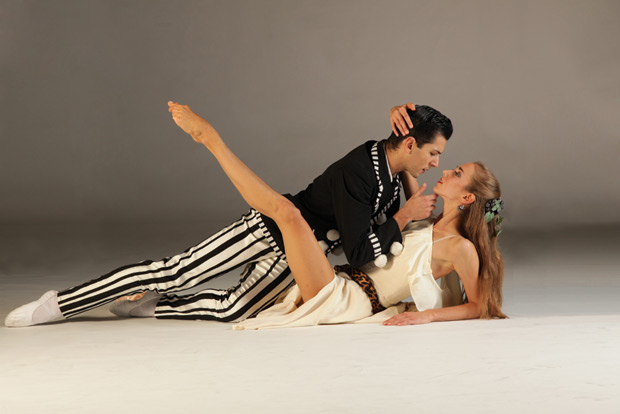
© Frank Atura. (Click image for larger version)
Sarasota Ballet
Sir Frederick Ashton Festival:
Program I: Birthday Offering, Illuminations, Façade
Program II: Les Rendezvous, Monotones I and II, Façade
Program III: Birthday Offering, Valses Nobles et Sentimentales, Sinfonietta
Program IV: Illuminations, Divertissements, Les Patineurs
Sarasota, Opera House.
30 April-3 May 2014
www.sarasotaballet.org
sarasotaballet.org/ashton-festival
www.frederickashton.org.uk
Following Sir Fred’s Steps – online book of 1994 Ashton conference
www.ashtonarchive.com
Ashton in Florida
More or less the last place you’d expect to find a festival devoted to the ballets of Frederick Ashton is the Gulf Coast of Florida. But Sarasota is not your typical Florida coastal getaway, despite the powdery-white beaches and crystalline, jade-colored waters. The town of 50,000 has an opera company (with its own Italian-revival 1920’s opera house), a yearly film festival, a symphony orchestra, and, yes, a ballet company, founded in 1990.

© Frank Atura. (Click image for larger version)
Seven years ago, the Yorkshire-born Iain Webb, a former dancer with the Sadler’s Wells Royal Ballet and London’s Royal Ballet (where he performed mostly character roles), was brought on as the new artistic director of the Sarasota Ballet. In addition to his connections – he is on excellent terms with the Birmingham Royal Ballet, which has lent him several productions, and Alina Cojocaru and Johan Kobborg have performed in Sarasota more than once – Webb brought with him a most precious asset: his wife, Margaret Barbieri, a ballerina with a long career at the Royal Ballet Touring Company and, ultimately, Birmingham Royal Ballet. She is the company’s assistant director, working mainly behind the scenes. (She made only one public appearance during the festival, lasting less than five minutes, then rushed off to a rehearsal.)
Since his arrival, Webb has ambitiously expanded the company’s repertoire, introducing works by Ashton (eighteen in all), Antony Tudor, Kenneth McMillan, Matthew Bourne, Ninette de Valois, and William Tuckett – all British – alongside ballets by Balanchine, Twyla Tharp, and others. (In 2011, the company collaborated with Suzanne Farrell on a staging of Diamonds at the Kennedy Center.) But at the heart of Webb and Barbieri’s efforts lies their devotion to Ashton, both as a choreographer and as a mentor. Webb, whose career spanned the eighties and early nineties, worked with the choreographer on the revivals of several ballets, including Valses Nobles et Sentimentales, Cinderella, and Two Pigeons. Barbieri, a decade his senior, danced a long series of leading Ashton roles, including Lise in La Fille Mal Gardée and the Young Girl in The Two Pigeons.
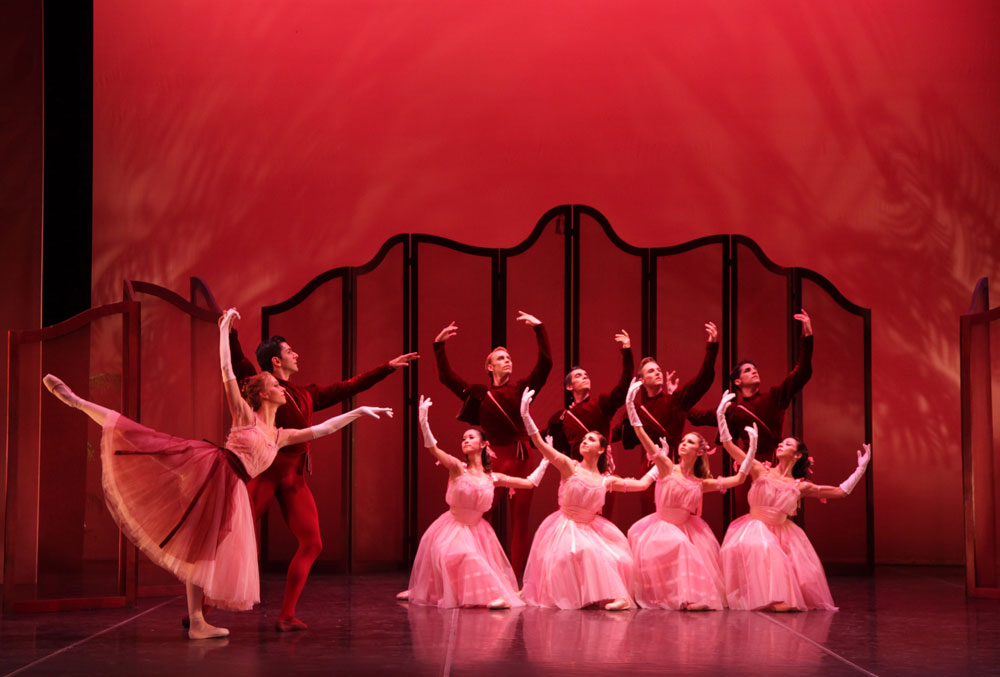
© Frank Atura. (Click image for larger version)
At several points during the four-day festival (April 30-May 3), Webb spoke with humor and affection of Ashton’s dry – but not unkind – sense of humor and of the pleasure with which he illustrated details in the studio, particularly when demonstrating the ballerina’s steps. One of Ashton’s enduring inspirations was the early twentieth-century ballerina Anna Pavlova, whom he had seen perform as a young man growing up in Lima, Perú (his father was a diplomat). Her stylistic DNA is everywhere in Ashton’s work, in the softness of the arms and the suppleness of the torso, the delicate use of the feet, the obliqueness of the poses, the almost exaggerated femininity of his female roles and the surprising, seemingly spontaneous twists of his choreographic resolutions. Ashton even inscribed a particular sequence of steps he had seen her perform, known as the “Fred Step,” into many of his dances. (Usually, the Fred Step sneaks up on you when you least expect it; with its gentle rocking quality, you tend to feel it before you see it.)
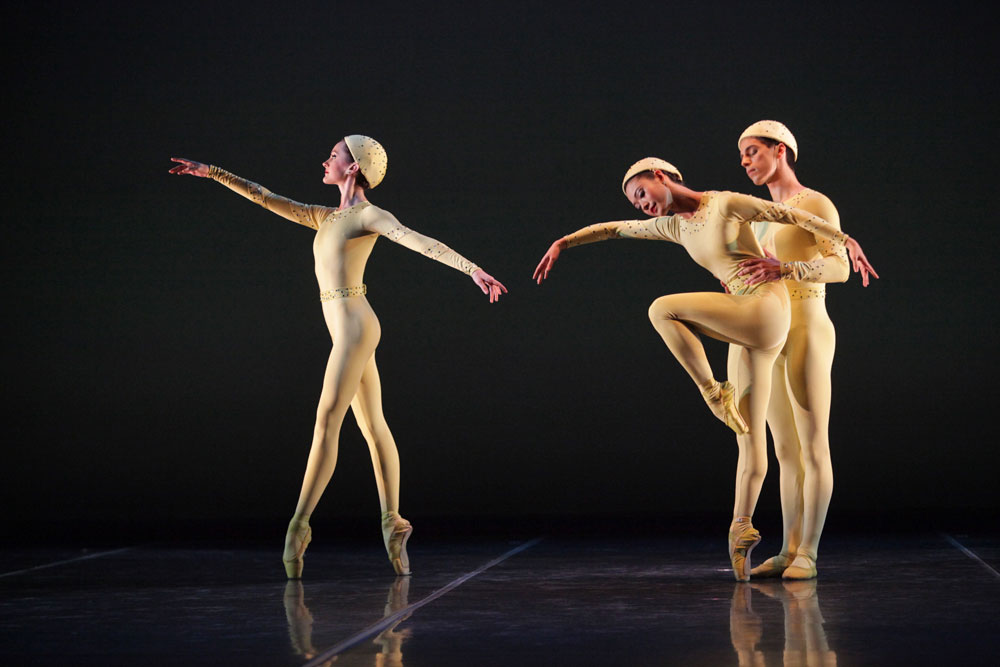
© Gene Schiavone. (Click image for larger version)
This sense of affectionate tribute permeated the proceedings in Sarasota, from the panels to the pre-show introductions to the performances themselves. In an open class, held on the stage of the Sarasota Opera House, Webb gently ribbed his dancers, poking fun at one young man one for his reticence in an across-the-floor exercise – “forgive him,” he said, “he’s English.” But despite his affable manner, he was insistent about the qualities he expected to see: expressive, generous movements of the arms, shoulders, and neck. Repeatedly, he exhorted them to bend, twist, and reach into space, following each movement with their faces and eyes. “Hello barre, hello center,” he serenaded as they did their pliés.
The performances exuded the same spirit, which is remarkable for a company of young dancers who probably had only a vague notion of Ashton’s style before joining. With the exception of The Dream, Ashton’s works are not mainstays of American ballet, and they have been falling out of the British repertoire as well. Two of the nine works performed, Valses Nobles et Sentimentales and Sinfonietta, had not been seen for decades before they were revived in Sarasota in the last two years. There is no denying that there is something slightly old-fashioned about many of the ballets – they don’t display the striking modernity or dynamism of Balanchine – and this may be one of the reasons they have fallen out of favor. Ashton was not primarily an innovator, but rather a lover of ballet’s quirks, quaintness, and its capacity to express humor, love, and human frailty.

© Frank Atura. (Click image for larger version)
With their fine-grained footwork and generous use of the upper-body, these ballets aren’t easy to dance, either. So it’s quite a feat to look – as the Sarasotans do–like they’ve been dancing them their whole lives. Of the nine works, all were performed at a very high level, even though, as one might expect, this is not a company of spectacular virtuosos. Among the men, the Brazilian-born Ricardo Graziano stands out for his relaxed, beautifully-coordinated technique, his intense and sensitive stage presence, and his assured partnering. (His second performance of Illuminations (1950) was the most dramatic moment of the festival.) The diminutive, spritely Logan Learned provides the fireworks – jumping, turning, bending, doing flips – as he proved in the sunny Les Patineurs (1937) at the close of the festival. Dancing principal roles in both Les Rendezvous (1933) and Birthday Offering (1956), Ricardo Rhodes revealed himself to be an appealing leading man, though his landings could be softer and his footwork a bit more lively. Among the lower ranks, Juan Gil (originally from Spain) was sharp and clear, making a vivid impression in Façade’s “Popular Song,” the ensemble sections of Valses Nobles, and the first movement of Sinfonietta.
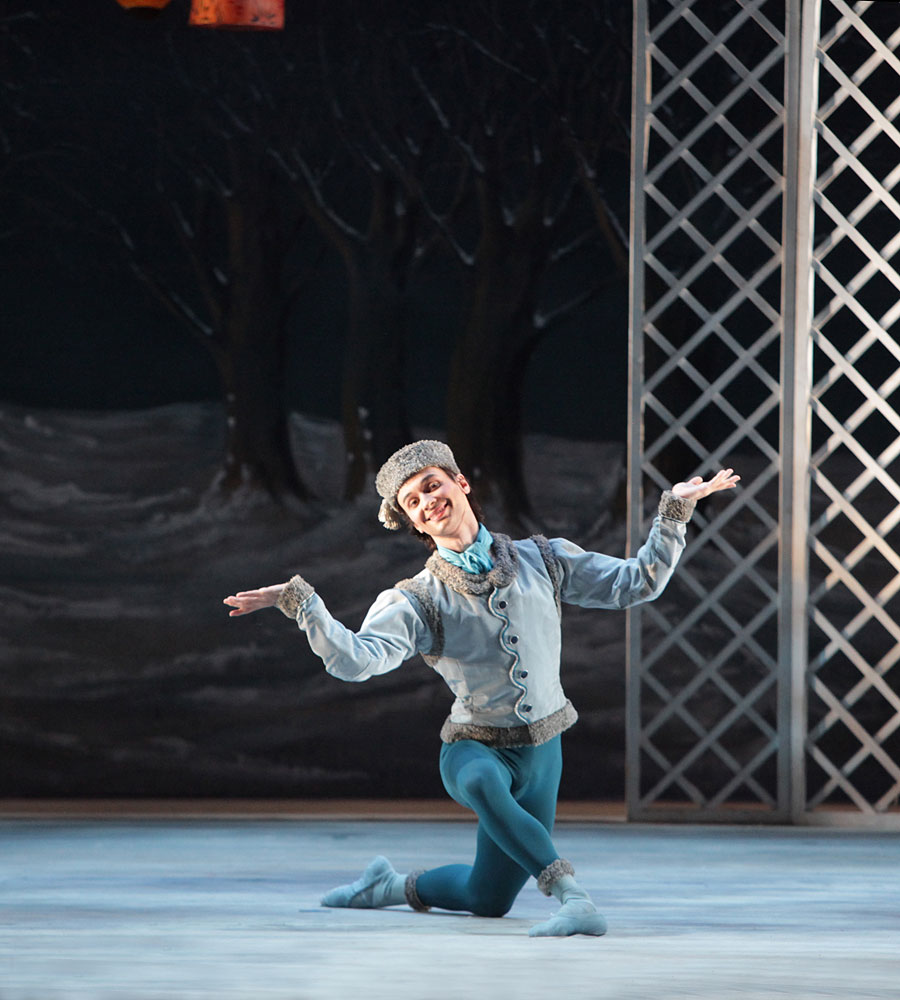
© Frank Atura. (Click image for larger version)
But what really impressed was the depth of talent among the women. Every ballet had me scrambling to decipher the names in the program. In an exceptional cast of Façade (made in 1931 and set to William Walton’s witty suite) on the first night, Kate Honea was both hilariously zany and crisply precise as the Milkmaid. The classical showpiece Birthday Offering (1956), laid out like a necklace of pearlescent miniatures, each with its own obstacle course of classical steps, was the ultimate test, requiring not one but seven ballerinas with style, aplomb, and character – not to mention technical chops – to pull it off. (Lest we forget, the roles were created for Margot Fonteyn, Beryl Grey, Nadia Nerina, etc.) Sarasota Ballet presented not one but two casts (with some overlapping roles), both strong.
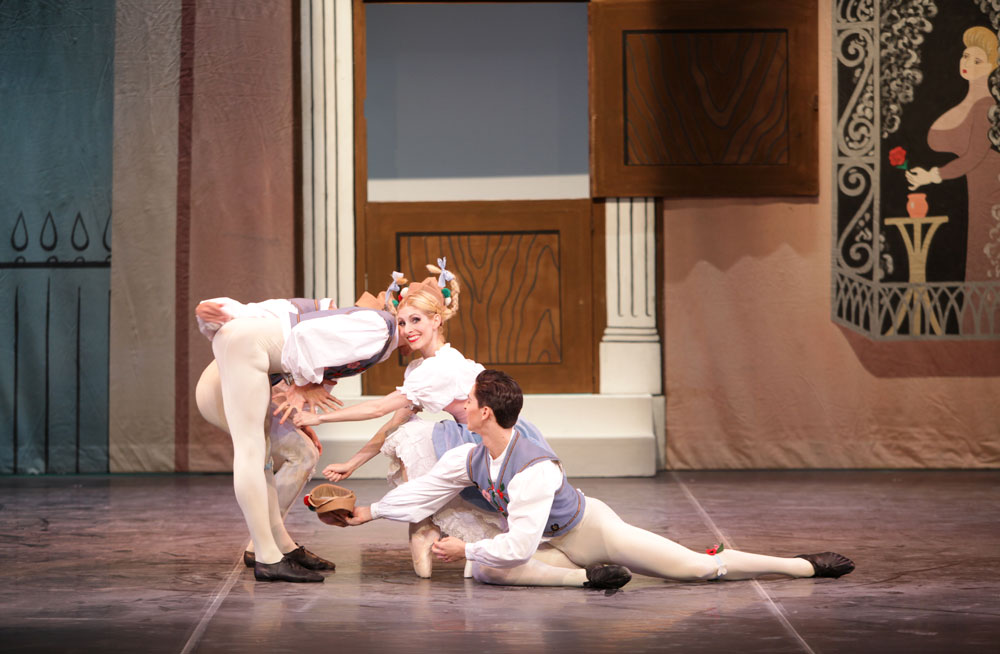
© Frank Atura. (Click image for larger version)
Danielle Brown is perhaps the company’s most complete ballerina, unflappable in every respect, as well as stylish. (She can also be quite funny, as she showed in her turn as the débutante in the tango in Façade.) By its very nature, Birthday Offering can come across as over-formal and presentational – more a showcase than a ballet – but these dancers gave it life and charm even when, as on May 2, it was performed to recorded music. (Only the first and last evening had live musical accompaniment, provided by the Sarasota Orchestra, conducted with verve by Ormsby Wilkins, of American Ballet Theatre. It made all the difference.) The details of the choreography came through: the Alice-in-Wonderland angles of the head, the scooping wrists, the beautifully-three-dimensional poses, soft shoulders, and slow, cushioned sissonnes. In Svetlana Beriosova’s role, Ryoko Sadoshima danced with a wonderfully creamy, legato quality. Nicole Padilla was pert and playfully musical. In fact, the entire company seems to be unusually musical.

© Frank Atura. (Click image for larger version)
If Birthday Offering was the ultimate technical test, then Illuminations (1950) was the most difficult work to pull off dramatically. It too was performed twice, by the same cast. Originally created for New York City Ballet, with commedia dell’arte designs by Cecil Beaton (borrowed here from the Royal Ballet), it is a hallucinatory piece meant to evoke the frazzled world-view of the poet figure that lies at the heart of Rimbaud’s prose poems. The poems, in turn, are filtered through Benjamin Britten’s eponymous 1939 song cycle. (The lyrics were sung by a rather reedy tenor who at times sounded uncannily like Peter Pears, with whom the songs are closely identified.) Ashton’s imagery only loosely follows the text – how does one translate Rimbaud’s surrealist word-paintings into movement? (Just a taste: “Des chalets de cristal et de bois se meuvent sur des rails et des poulies invisibles.”) Instead, the choreographer responded with dreamy tableaux filled with sleepy Harlequins (à la early Picasso), puppet-like kings and queens, evocations of vigorous lovemaking and surprisingly frank auto-eroticism, and the fairy-like presence of a Columbine figure who drifts, mysteriously, beyond the hero’s reach. (As the poet’s sultry lover, Ellen Overstreet was both convincingly wanton and touchingly vulnerable.)
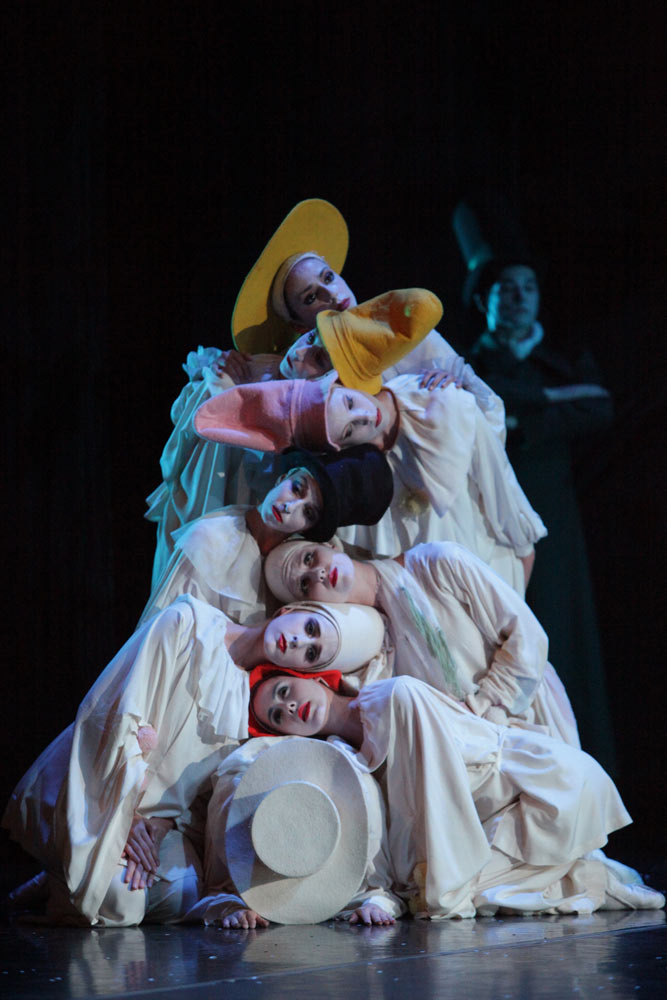
© Frank Atura. (Click image for larger version)
Ahston’s choreography is less modern than Britten’s music, with its smears of sound, and less feverish than Rimbaud’s suffocating verse. But on second view Illuminations casts its own spell as a kind of Ballets Russes-like pantomime full of outlandish characters: dandies, town criers, soldiers, coachmen. An image of piled heads pays tribute to Nijinska’s Les Noces. What ties it all together is the figure of the suffering poet, played with real intensity – but without the slightest hint of exaggeration – by Graziano.
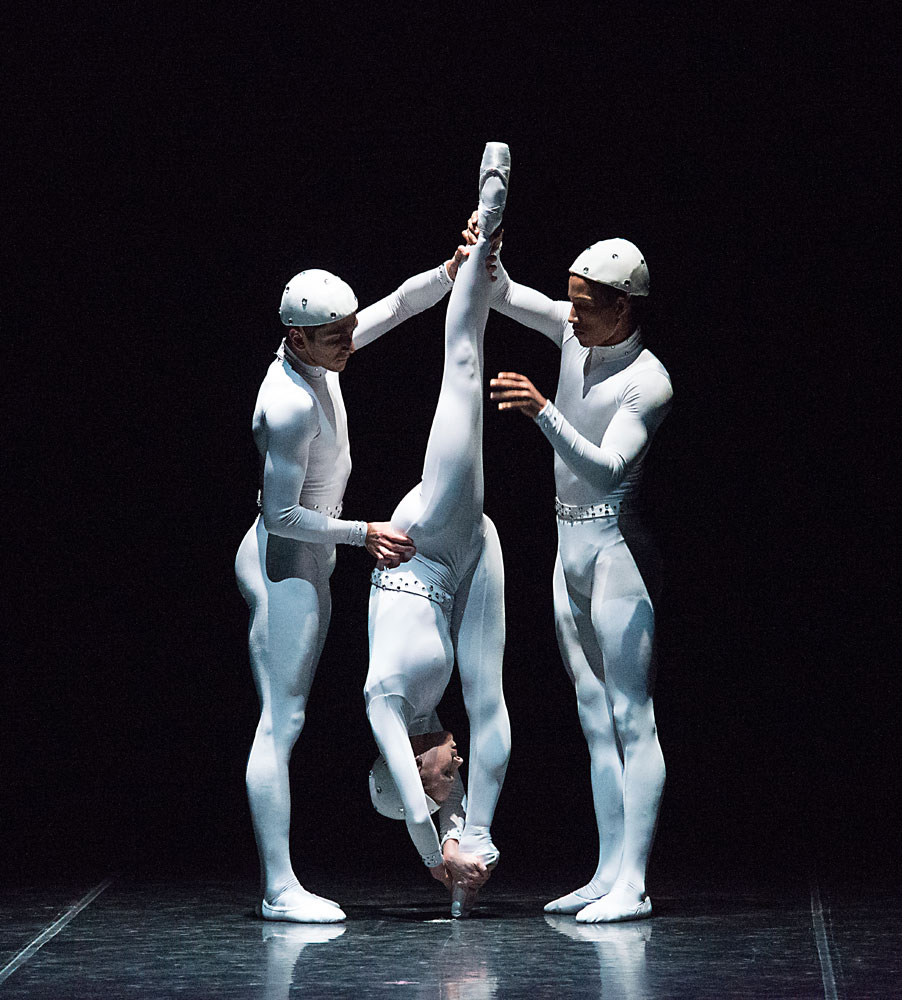
© Gene Schiavone. (Click image for larger version)
The advantage of putting all these ballets on the stage in quick succession is that the audience begins to see all sorts of interconnections and motifs running through the works. Thus, in Monotones II (1965), there is an echo of the slow trio near the beginning of Valses Nobles et Sentimentales, in which a woman is slowly revolved by two men and shown from all angles, the center of a slow-moving planetary system. (This also happens in Enigma Variations, shown in a film with its original cast.) In Valses, Danielle Brown, pulled between her two suitors, was a commanding presence, a woman sure of her place in the world, while Amy Wood, in Monotones II, projected a remote, hieratic quality, like a saint in a Byzantine icon. Trios were a constant feature, as were perfectly synchronized duets (just think of the two female duos in Les Patineurs), light, trill-like bourrées, low jumps (especially sissonnes), leaps to the knee, poses with one hand on the shoulder, and simple, kitchen-sink steps like the chassé. It seems that Ashton had a fascination for the entire nineteenth-century vocabulary. Certain images function as leitmotifs. Women are lifted horizontally from below, hovering in mid-air, like the Lilac Fairy in Sleeping Beauty. A girl in Les Rendezvous (1933) whirls her arms as she sits on the floor, like a sylph in La Sylphide. Uplifted arms, reminiscent of images of Pavlova, return again and again. Ballet’s past hovers like a sweet perfume.
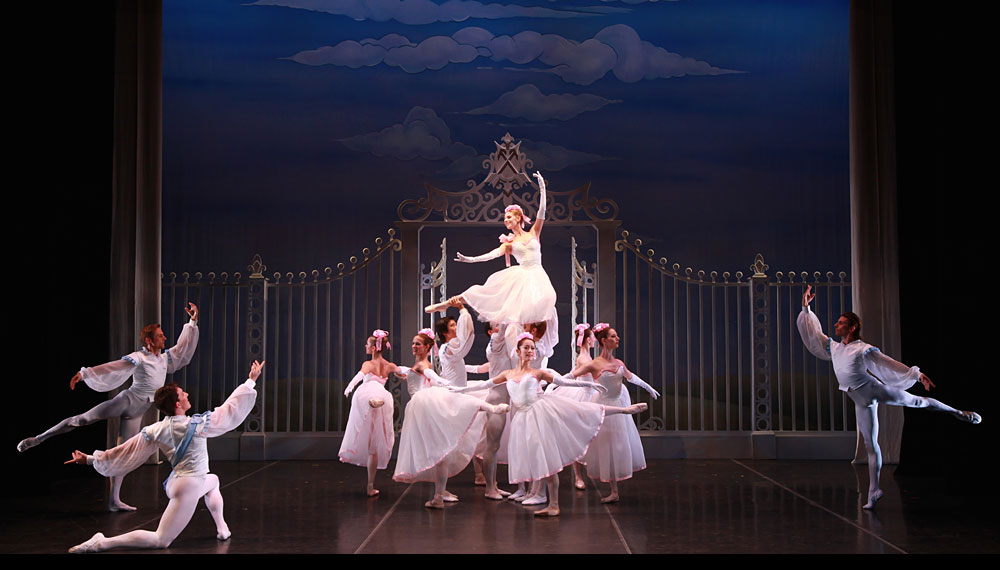
© Frank Atura. (Click image for larger version)
Inevitably, some works come up short. Sinfonietta (1967), though charming and comparatively quick-paced, looks too self-consciously Balanchinean, while lacking the full-on dynamism and attack of Balanchine. Valses Nobles, a dreamy, misty ballet set to Ravel waltzes, has its mysteries, but pales in comparison to Balanchine’s demonic La Valse (also set to Ravel waltzes, also located in a ballroom). Not all of the divertissements performed on the last night were worth reviving, though the “awakening” pas de deux from Ashton’s 1968 Sleeping Beauty, in which the lovers step backwards to peer shyly into each other’s eyes, brought tears to my eyes. (It was performed with bracing simplicity by Sadoshima and Rhodes.)
And sometimes a revival is simply a pretext for showing off a particularly exciting new dancer. This was the case with Voices of Spring (1977) a short pas de deux set to Strauss’s eponymous waltz, which Jessica Cohen, now in her first season, tossed off with exceptional musicality and a kind of joyful effervescence, down to the final moment in which her partner (Graziano) tossed her up into the air, caught her with one hand in an overhead lift, and whisked her offstage.

© Frank Atura. (Click image for larger version)
Both as a tribute to Ashton and as a coming-out party, it’s hard to imagine how the festival could have gone better. The ballets are in good hands. Seeing them in such taut form may even encourage more companies to try their luck at Ashton. Wouldn’t that be nice? And who knows what could lie in store for this lovely company? Good things, surely.












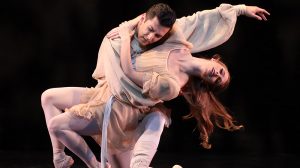

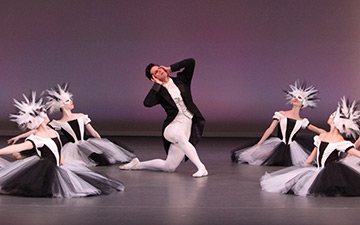


You must be logged in to post a comment.